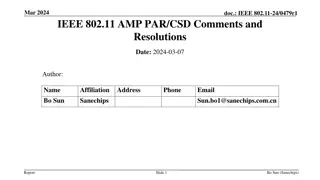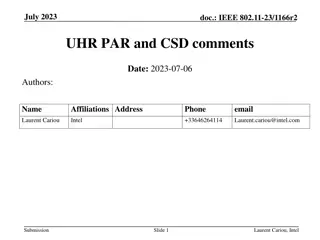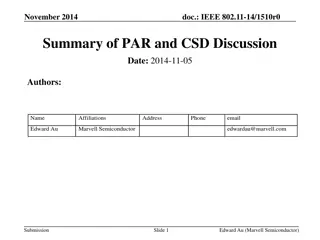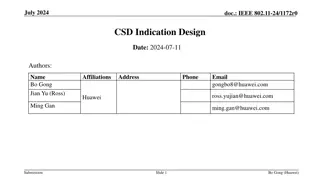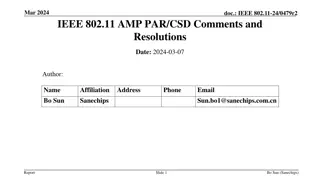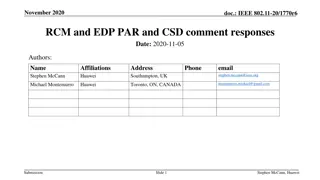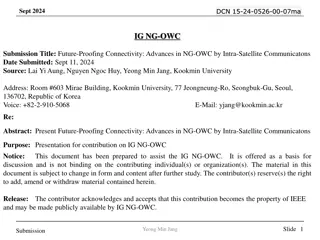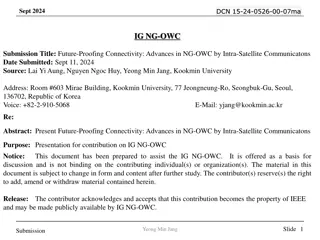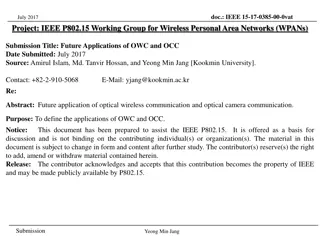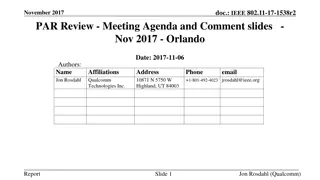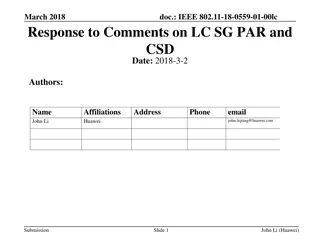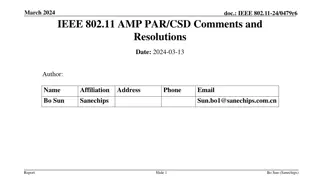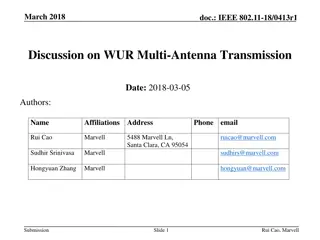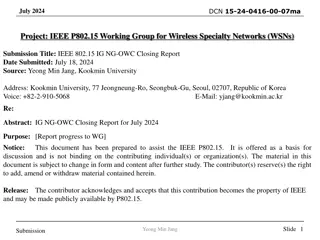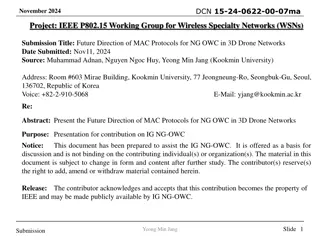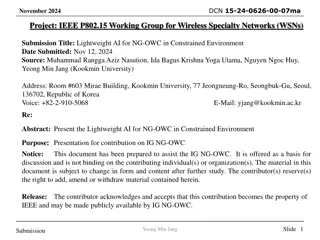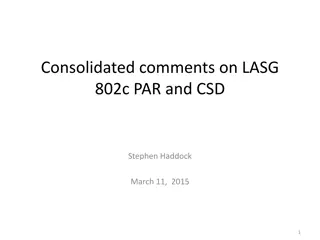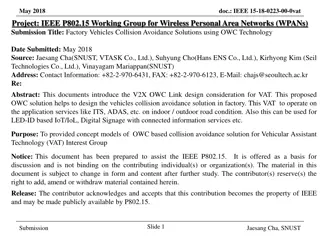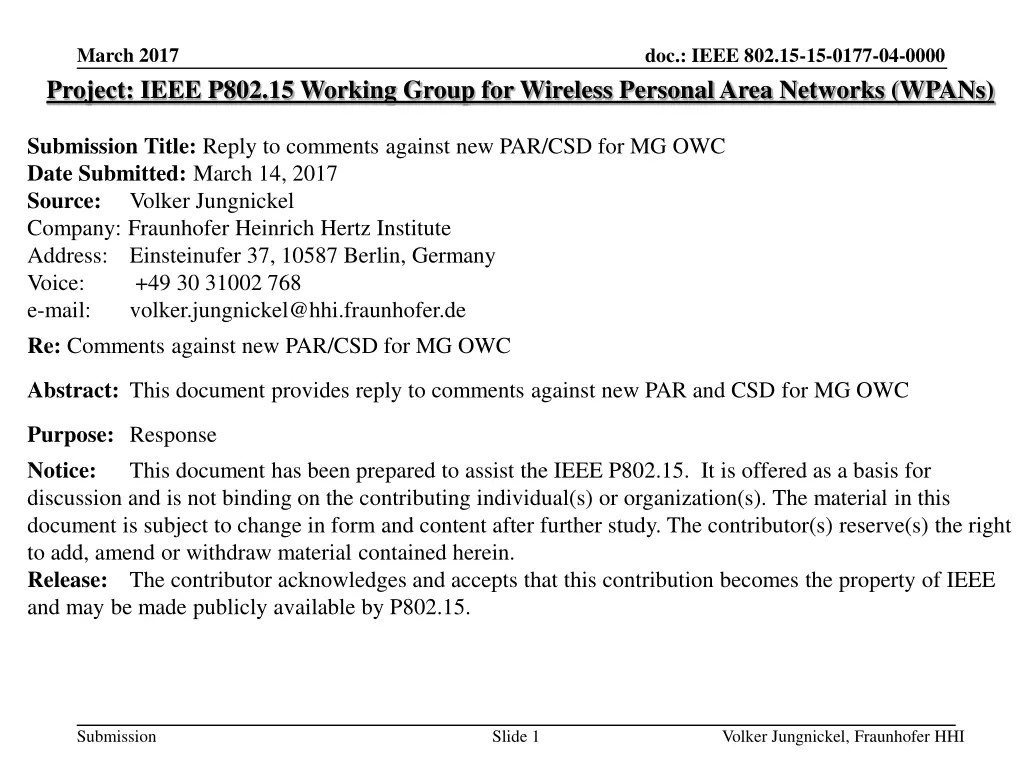
IEEE 802.15 Working Group Reply to Comments on New PAR/CSD for MG OWC
"This document provides a response to comments against the new PAR and CSD for MG OWC within the IEEE 802.15 Working Group, addressing concerns and clarifying the project scope and rationale. It outlines the project's objectives and approach, emphasizing the importance of collaboration and efficiency in completing the work effectively."
Download Presentation

Please find below an Image/Link to download the presentation.
The content on the website is provided AS IS for your information and personal use only. It may not be sold, licensed, or shared on other websites without obtaining consent from the author. If you encounter any issues during the download, it is possible that the publisher has removed the file from their server.
You are allowed to download the files provided on this website for personal or commercial use, subject to the condition that they are used lawfully. All files are the property of their respective owners.
The content on the website is provided AS IS for your information and personal use only. It may not be sold, licensed, or shared on other websites without obtaining consent from the author.
E N D
Presentation Transcript
March 2017 Project: IEEE P802.15 Working Group for Wireless Personal Area Networks (WPANs) doc.: IEEE 802.15-15-0248-00-007a doc.: IEEE 802.15-15-0177-04-0000 Submission Title: Reply to comments against new PAR/CSD for MG OWC Date Submitted: March 14, 2017 Source: Volker Jungnickel Company: Fraunhofer Heinrich Hertz Institute Address: Einsteinufer 37, 10587 Berlin, Germany Voice: +49 30 31002 768 e-mail: volker.jungnickel@hhi.fraunhofer.de Re: Comments against new PAR/CSD for MG OWC Abstract: This document provides reply to comments against new PAR and CSD for MG OWC Purpose: Response Notice: discussion and is not binding on the contributing individual(s) or organization(s). The material in this document is subject to change in form and content after further study. The contributor(s) reserve(s) the right to add, amend or withdraw material contained herein. Release: The contributor acknowledges and accepts that this contribution becomes the property of IEEE and may be made publicly available by P802.15. This document has been prepared to assist the IEEE P802.15. It is offered as a basis for Submission Slide 1 Volker Jungnickel, Fraunhofer HHI
March 2017 doc.: IEEE 802.15-15-0248-00-007a doc.: IEEE 802.15-15-0177-04-0000 802.3 Comments on 15.11 OWC- General General C: The project documents do not give any indication why this project should be done in 802.15. R: It would make sense to complete this work in 802.15 since it is already ongoing as part of the 15.7 revision. What we have discovered is this would be better handled as a stand alone project since its MAC needs are not in sync with those for 15.7. Splitting up the activity will allow both projects to complete more quickly and at higher quality. Beyond that, the majority of OWC experts in 802 are in 802.15 C: It gives no indication of distance the optical communications are to address, no indication of the project having similarities to leverage from other 802.15 projects. R:Added to the scope the clause at distances in the range of 200 meters unrestricted line of sight In terms of similarities, it does use optical frequencies for the communications so the knowledge gained in 15.7 is useful here Slide 2 Submission Volker Jungnickel, Fraunhofer HHI
March 2017 doc.: IEEE 802.15-15-0248-00-007a doc.: IEEE 802.15-15-0177-04-0000 802.3 Comments on 15.11 OWC-General (2) C: From the documents, it is impossible to make the determination if the new PAR should be assigned to the 802.15 WG, another WG, or a new WG. R:It would make sense to complete this work in 802.15 since it is already ongoing as part of the 15.7 revision. What we have discovered is this would be better handled as a stand alone project since its MAC needs are not in sync with those for 15.7. Splitting up the activity will allow both projects to complete more quickly and at higher quality. Additionally, the majority of OWC subject matter experts in 802 are in 802.15. C: The documents do not provide any indication to a reader if they are an interested party (e.g., as a manager, should I send one of my employees to the meetings). R: Agreed. One is either interested in OWC or not. We do not feel this is part of our project goals Slide 3 Submission Volker Jungnickel, Fraunhofer HHI
March 2017 doc.: IEEE 802.15-15-0248-00-007a doc.: IEEE 802.15-15-0177-04-0000 802.3 Comments on 15.11 OWC PAR (1) PAR C: 2.1 Title: The title could apply to any 802 standard. In the past, people even discussed doing an optical wireless PHY for 802.3. Though optical is distinctive, there should be more distinctive information in the title, e.g., something about range of the wireless communication PAN. R: Title has been changed to read: Multi-Gigabit per Second Optical Wireless Communications (OWC) with Ranges up to 200 meters C: 5.1 expected number active on project: The number looks like WG members, not those expected to be active on P802.15.11 draft development and expert review. R: Number changed to 15 Slide 4 Submission Volker Jungnickel, Fraunhofer HHI
March 2017 doc.: IEEE 802.15-15-0248-00-007a doc.: IEEE 802.15-15-0177-04-0000 802.3 Comments on 15.11 OWC PAR (2) C:5.2 Scope The scope does not align with the Title (1 Mb/s is not multi-Gb/s). The communication distance to be specified in the standard should be specified in the scope. R: Scope language changed to (also addressing a comment from Paul Nikolich) The standard is capable of delivering data rates up to 10 Gbit/s at distances in the range of 200 meters unrestricted line of sight. Slide 5 Submission Volker Jungnickel, Fraunhofer HHI
March 2017 doc.: IEEE 802.15-15-0248-00-007a doc.: IEEE 802.15-15-0177-04-0000 802.3 Comments on 15.11 OWC PAR (3) C:5.4 Purpose: The purpose describes industrial applications as the driving application, yet requirements of automaton islands are very different from communication across a factory floor that can be a kilometer or more. There is not enough information to understand the technical problems that will need to be addressed (e.g., how bad are the multi-path, cross talk and other issues). R: In addressing a comment from Paul Nikolich, the purpose has been modified to read: The purpose of this standard is to define OWC specifications in optically transparent media enabling high data rate transfer among end points at rates up to 10 Gbit/s and ranges up to 200 meters unrestricted line of site and which are capable of meeting the needs of industrial and similar classes of applications requiring, secure, high performance, high data rate communications which are non-interfering with existing RF systems. Nailing down the detailed technical requirements will be considered as part of the project activity Slide 6 Submission Volker Jungnickel, Fraunhofer HHI
March 2017 doc.: IEEE 802.15-15-0248-00-007a doc.: IEEE 802.15-15-0177-04-0000 802.3 Comments on 15.11 OWC PAR (4) C: 5.6 Stakeholders: The stakeholders do not appear to align with the purpose statement. Without reach information, are the stakeholders the manufacturers of the manufacturing equipment used to make aircraft and other transportation devices, or is the industry simply the users of the equipment that includes the proposed optical communication capabilities? R: Purpose statement has been modified and should now be consistent with listed stakeholders C: 6.1, b) registration activity: If the standard is expected to specify the use of OUI, CID EUI-48 or EUI-64, it does have registration activity. R: Agreed. Answer changed to yes. Slide 7 Submission Volker Jungnickel, Fraunhofer HHI
March 2017 doc.: IEEE 802.15-15-0248-00-007a doc.: IEEE 802.15-15-0177-04-0000 802.3 Comments on 15.11 OWC CSD (1) CSD C: 1.2.1, a) Broad Market: 802.3 has industrial applications and is familiar with shorter range automation islands and longer factory floor requirements, but has no idea what a "personalized manufacturing cell" is other than jargon. R:Revise sentence in the CSD to read: Potential applications include control of mobile robots in manufacturing cells or on assembly lines, Also update the last sentence in the PAR Need in a similar way. C: Though less important, what relevance the speed of a train has for internal communications is not clear. R:It has none. high-speed has been removed Slide 8 Submission Volker Jungnickel, Fraunhofer HHI
March 2017 doc.: IEEE 802.15-15-0248-00-007a doc.: IEEE 802.15-15-0177-04-0000 802.3 Comments on 15.11 OWC CSD (2) C: 1.2.3 Distinct Identity: What is the phrase in transparent media supposed to mean? Wouldn't the non-fiber excluded by 1.2.1, b) be transparent? If the requirement is to be only free space, line of sight, then the airplane environment would be very difficult to satisfy without reflective (i.e., non- transparent) transmission. R: Transparent media is just what it implies. For visible light that could be water, oil, air, vacuum etc. The fact that it is Optical Wireless Communications excludes fiber. There is no requirement that this be just free space, line of site. With RF systems we typically provide baseline conditions which are well know like Open Field range when in fact these systems are used indoors and all sorts of other environments. This is no different. Also, just like RF systems, reflections are part of the channel model. Same here just at higher frequencies Slide 9 Submission Volker Jungnickel, Fraunhofer HHI
March 2017 doc.: IEEE 802.15-15-0248-00-007a doc.: IEEE 802.15-15-0177-04-0000 802.3 Comments on 15.11 OWC CSD (3) C: 1.2.4 Technical Feasibility Because there are virtually no technical restrictions on what the standard will specify, this response has little credibility (e.g., does the answer about devices being available hold for the entire frequency range specified for the standard, for all the unrestricted transmission modes, the range of operational speeds, etc.). R: The Demonstrated Feasiblity entry in 1.2.4 has been modified to read: Devices are available in the entire frequency range. Tests, demonstrations, measurements and simulations have been conducted for selected wavelengths from UV to IR by both academic and commercial institutions, verifying that the OWC capabilities of distance and speed needed for this standard are feasible over the full frequency range. Slide 10 Submission Volker Jungnickel, Fraunhofer HHI
March 2017 doc.: IEEE 802.15-15-0248-00-007a doc.: IEEE 802.15-15-0177-04-0000 Paul Nikolich Comments on 15.11 OWC PAR C: 5.2 Scope uses the vague term "mobility" which leaves much room for interpretation, I think it would help to define the term more precisely. Within this project's scope, please provide a specific definition of "mobility" (or reference a well known more specific definition). R: Agreed. Modify that sentence to read: The standard includes adaptation to varying channel conditions and maintaining connectivity while moving within the range of a single coordinator or moving between coordinators. C: 5.3- Participation: what is the rationale for an estimate of 80 participants? It is optimistic, please try to be realistic. R: That was the number of WG participants. Number has been revised to 15 for project participants Slide 11 Submission Volker Jungnickel, Fraunhofer HHI
March 2017 doc.: IEEE 802.15-15-0248-00-007a doc.: IEEE 802.15-15-0177-04-0000 Paul Nikolich Comments on 15.11 OWC PAR C: 5.2 Scope: please specify what "heterogeneous operation" means R: This sentence has been removed from the scope. Instead an explanatory sentence has been added to 8.1 which reads: Line 5.2: The standard may include MIMO, and mechanisms enabling heterogeneous operation, ie operation with both OWC and existing RF wireless data communications standards in the same network C: 5.2 Scope: please consider adding a link range objective (1m? 10m? more? less?) under simply described nominal channel conditions (e.g., unobstructed line-of-sight) R: Range has been added in response to a comment from 802.3 C: 5.2 Scope: please consider adding a bit error rate objective for the above channel condition R: We have considered this, but feel it is not necessary since the desired data rates and ranges assumes that channel characteristics and likely error rates have to taken into consideration in order to achieve the expected results Slide 12 Submission Volker Jungnickel, Fraunhofer HHI
March 2017 doc.: IEEE 802.15-15-0248-00-007a doc.: IEEE 802.15-15-0177-04-0000 Paul Nikolich Comments on 15.11 OWC PAR (2) C: 5.4 Purpose: The purpose reads more like the description of a the applications of network product family that embodies interfaces that conform to the (eventual) 802.15.11 standard than the purpose of the the technical specifications the standard defines. This text is good, but reads like it belongs in 5.5 Need, not 5.4 Purpose. Please consider reworking the purpose along the lines of something like this: The purpose of the standard is to define free space optical interface specifications to establish high data rate transfer among end points. R: We have modified the purpose to read: The purpose of this standard is to define OWC specifications in optically transparent media enabling high data rate transfer among end points at rates up to 10 Gbit/s and ranges up to 200 meters unrestricted line of site and which are capable of meeting the needs of industrial and similar classes of applications requiring, secure, high performance, high data rate communications which are non-interfering with existing RF systems. Slide 13 Submission Volker Jungnickel, Fraunhofer HHI
March 2017 doc.: IEEE 802.15-15-0248-00-007a doc.: IEEE 802.15-15-0177-04-0000 Paul Nikolich Comments on 15.11 OWC PAR (3) C: 7.1) Other standards/projects: We know 802.11 has a Light Communication Technical Interest Group that may result in a project, this should be noted as a possibility even though it isn't definite. What research have you done to identify similar standards activities within the IEEE or external to the IEEE? R: There are two other activities but one is not yet a project or a standard and the other is more like 802.15.7 rather than this proposed project. Technically the correct answer to 7.1 is NO but we will add an explanatory comment to 8.1which reads: Line 7.1: Technically there are no standards or projects with a similar scope, but ITU-T defines a new recommendation for visible light communications (i.e. no IR and UV) and is currently in a process to align its objectives according to work done previously in IEEE 802.15.7. There is also an Interest Group activity in 802.11 looking at where OWC might fit as part of a WLAN. C: 4.2 Sponsor Ballot by March 2018 seems unrealistically optimistic for a new standard with this scope, please explain. R: This basis of this project is largely complete as a result of the work to date in 802.15.7m. Consequently the effort to complete this project should move quickly, especially as a result of the restructuring of this activity. Even so we will change this to Nov 2018 to be on the conservative side. Slide 14 Submission Volker Jungnickel, Fraunhofer HHI
March 2017 doc.: IEEE 802.15-15-0248-00-007a doc.: IEEE 802.15-15-0177-04-0000 802.11 Comments on 15.11 OWC PAR C: Project Number: The Par Number of 802.15.11 is potentially confusing, Please change. Propose 802.15.13. R: Agreed. Project name will be changed to 802.15.13 C:Title why the /s at the end of Gigabit? Strictly speaking Multi-Gigabit is a size parameter rather than a speed rate. The /s may have meant per second but consider replacing /s and spell out the per second. Suggested title change to Multi-Gigabit per second Optical Wireless Communication R: Title changed to reflect suggested resolution Slide 15 Submission Volker Jungnickel, Fraunhofer HHI
March 2017 doc.: IEEE 802.15-15-0248-00-007a doc.: IEEE 802.15-15-0177-04-0000 802.11 Comments on 15.11 OWC PAR (2) C: 5.2 Is the scope an overlap with the existing 802.15.7 standard? The use of the word Optical seems to confuse this standard with the previous standard. 7.1 include description of differences to similar project 802.15.7 R:The scopes are not overlapping. They just happen to be using the same band as many of our projects do. This project moves beyond 15.7, including range, speed, and coordinated topologies. The use of the term Optical is no different than the use of the term RF. We certainly have multiple standards which use the term RF without confusion. It is what features/functions that are delivered by the MAC/PHY that are important. 7.1 is specifically standards or projects with a similar scope and not the right place to discuss differences. These differences are spelled out in the CSD. Slide 16 Submission Volker Jungnickel, Fraunhofer HHI
March 2017 doc.: IEEE 802.15-15-0248-00-007a doc.: IEEE 802.15-15-0177-04-0000 802.11Comments on 15.11 OWC CSD C:General CSD Comment: When citing standards, add IEEE std throughout CSD. R: Agreed C: 1.2.3 Distinct Identity, 1. Consider including some of this to the need statement of the PAR to show the need for the project. R: We appreciated the comment but have decided to leave this section basically as is with the exception of 3) below. 2. Typo mutli should be multi thank-you 3. Starting the statement with With the exception seems an odd way to start a statement of Distinct Identity. Suggest deleting the phrase. R: agreed. 4. Add IEEE std before 802.15.7 when referring to the standard, and add 802 before 15.7 when meaning 802.15.7 R: agreed Slide 17 Submission Volker Jungnickel, Fraunhofer HHI
March 2015 doc.: IEEE 802.15-15-0248-00-007a doc.: IEEE 802.15-15-0177-04-0000 Comments from James Gilb C: - (5.2) "The standard adheres to applicable eye safety regulations." The standard cannot adhere to safety regulations (unless some really bad writing makes it through the process). Devices compliant to the standard could adhere to applicable eye safety regulations. Will the people developing the standard review all eye safety regulations for all countries? I would suggest deleting the sentence. Also note, that in the Style manual it says "The word safety should be avoided if it is being used to address a set of conditions or practices that have not been established for the purpose of promoting safety under all situations in which such conditions or practices will be employed. For example, 'the following 10 safety considerations should be reviewed before implementing this practice' should not be used." R: We agree, sentence is deleted. Submission Slide 18 Hsin-Mu (Michael) Tsai , NTU
March 2015 doc.: IEEE 802.15-15-0248-00-007a doc.: IEEE 802.15-15-0177-04-0000 Comments from James Gilb C: - (5.2) The Scope statement needs to be written in past tense, hence "may" is not correct in the sentence "For coordinated topologies, there may be one or more coordinators with the possibility of a global controller." Also, "global" is probably not correct, there will not be one controller for every system on the planet. Instead, I would suggest "For coordinated topologies, more than one peer coordinator is supported as well as topologies with multiple peer coordinators with master coordinator." R: Rephrase as For coordinated topologies with more than one peer coordinator there will be a master coordinator Submission Slide 19 Hsin-Mu (Michael) Tsai , NTU
March 2015 doc.: IEEE 802.15-15-0248-00-007a doc.: IEEE 802.15-15-0177-04-0000 Comments from James Gilb C: - (5.2) The Scope statement needs to be written in past tense, hence "may" is not correct in the sentence "The standard may include MIMO, relaying, and mechanisms enabling heterogeneous operation with existing RF wireless data communications standards" Also, relaying is out of scope, this should be handled by 802.1, not by creating a new bridging method. The best bet here is to delete the sentence. R: This sentence has been removed from the scope and replaced by an explanatory comment in 8.1 which reads: line 5.2: The standard may include MIMO, and mechanisms enabling heterogeneous operation, ie operation with both OWC and existing RF wireless data communications standards in the same network. Submission Slide 20 Hsin-Mu (Michael) Tsai , NTU
March 2015 doc.: IEEE 802.15-15-0248-00-007a doc.: IEEE 802.15-15-0177-04-0000 Comments from James Gilb C: - (5.4) "to provide a global solution initially", is confusing and too limiting. Is it only one solution for the entire globe? It would be better to say "to provide a solution initially" R:We agree. That has been removed and the purpose replaced by The purpose of this standard is to define OWC specifications in optically transparent media enabling high data rate transfer among end points at rates up to 10 Gbit/s and ranges up to 200 meters unrestricted line of site and which are capable of meeting the needs of industrial and similar classes of applications requiring, secure, high performance, high data rate communications which are non-interfering with existing RF systems. in response to a comment by Paul Nikolich C: - (5.4) "unlicensed" change to "license exempt" R: See resolution to comment above C: - (5.4) "(ii) inherent communication security due to inability to penetrate through optically opaque wall" would be true only if it is operated in an area completely enclosed with optically opaque materials, i.e., no windows, vents, etc. This is a pretty weak claim and should be deleted. R: See resolution to comment above C: (5.4) editorial: "low latency data transferring that meet" should be "low latency data transfer that meets" R: See resolution to comment above Submission Slide 21 Hsin-Mu (Michael) Tsai , NTU
March 2015 doc.: IEEE 802.15-15-0248-00-007a doc.: IEEE 802.15-15-0177-04-0000 Comments from Benjamin Rolfe C: (5.2) "The standard adheres to applicable eye safety regulations." All 802 standards include the following disclaimer: IMPORTANT NOTICE: IEEE Standards documents are not intended to ensure safety, security, health, or environmental protection, or ensure against interference with or from other devices or networks. Implementers of IEEE Standards documents are responsible for determining and complying with all appropriate safety, security, environmental, health, and interference protection practices and all applicable laws and regulations. the statements in 5.2 directly contradict this prohibition. Delete the sentence. R: We agree. Sentence removed from scope Submission Slide 22 Hsin-Mu (Michael) Tsai , NTU

